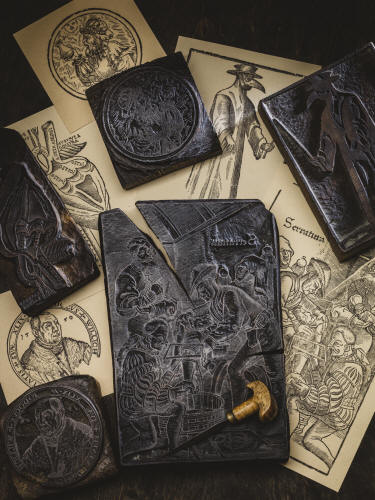 |
Medical Xylography Showing anatomy, surgery, bloodletting, and other medical procedures in print |
Examples of European medical images (xylography) in books, created by use of carved woodcut blocks
925 width
Xylography can be defined as the art of engraving wood for the purpose of printing. The wooden block is gouged and engraved along its grain to allow for the image to be printed on paper. This is done with a knife or chisel. What is left can be covered by ink with a roller (known as a brayer) and then, when pressed onto paper, the cut away areas of the block are white while the remaining image flush with the surface of the block will appear black. A more complex technique was sometimes used to produce “Chiaroscuro woodcuts,” which are multi-colored. That technique was invented in Germany in the early 16th century.
The art of xylography likely originated as early as the 8th century in Chinese Buddhist temples. In 764 the Empress Koken commissioned one million small wooden pagodas to be built in Japan. Each pagoda contained a small woodblock scroll that was printed with a Buddhist text. The purpose of the text was to give thanks for the suppression of the Emi Rebellion of 764. Woodblocks were used to produce religious scrolls and books in Japan in the following centuries, but non-religious works were not produced there until the 16th century.
European use of the woodcut as a means to produce old master prints began in the 15th century. One of the earliest such works is The Fire Madonna, which is in the Cathedral of Forli in Italy. Most of the earliest European woodcuts have religious themes. At the beginning of the 15th century there was an explosion in the sales of poorly made woodcuts, and there was a subsequent fall in standards. There was a lack of sophistication until the third quarter of the 16th century, when German and Italian artisans raised the level of the craft. Albrecht Durer was a master who brought the craft of xylography to its pinnacle at the end of the 15th Century.
Printing with moveable type began in the mid 15th century, and the combination of this printing technique with woodblock illustrations gave rise to the illustrated book. Millions of books were produced in Europe in the late 15th through late 17th centuries. There were likewise many thousands of original wooden blocks painstakingly created to produce the illustrations. Oftentimes, illustrations were “borrowed” from one book to another, either with or without permission. This is why the prints may look so similar in books by various authors.
Wooden printing blocks were designed by an artist/author and then carved by specialized artisans called “formschneiders.” This was done after a paper drawing was laid down on the block or if the illustration was drawn directly onto the block itself. Perhaps the height of the formschneider’s craft was seen in Germany, where carvers such as Hieronymus Andreae, Hans Lutzelburger, and Just de Negker became well known for their skill in carving the blocks. There were also specialists who were expert in producing blank blocks of the correct type and consistency for carving. (1)
Sadly, almost all of the original wooden blocks used to produce book illustrations in the 15th through 17th centuries have been lost. They were used until they could no longer produce a good image, and likely then cast into the fireplace. Sometimes they were re-carved to extend their life, but most commonly they were simply discarded at the end of a print run.
Amazingly, a large grouping of original early printing blocks were collected in the 19th century and kept together until recently. These blocks were in all genres: religion, art, history, and science. The Arbittier Museum of Medical History is very fortunate to have been able to acquire all of the medically related blocks in this important archive. These include ones showing anatomy, surgery, bloodletting, and other medical procedures. Many of the blocks are associated with specific editions of important early medical texts, such as those by Pare and Hundt. All of the blocks will be described on the site in the near future.
7/17/2024 8 AM: IMPORTANT DISCLAIMER
New York Times article link:
Between 2013 and 2016 I collected the blocks outlined below from a single source. As you will see from my descriptions, I felt these were extreme rarities that survived the centuries, when almost no other printing blocks similarly survived.It turns out that I, similar to other collectors and museums, was duped by a master counterfeiter who produced the blocks himself and made prints from them. This was a significant fraud and my desire to add historically important pieces to the collection blinded me to the fact they were fakes. The blocks were hand engraved by a master artist named Earl Washington. He did amazing work that mirrored the work that artisans did centuries ago. So, while these blocks are works of art, they are MODERN WORKS OF ART!
Washington pled guilty in a federal case and these blocks are no longer on display in the museum. I take great pride in the originality of all works in the museum, so when these were found to be inauthentic, they were immediately removed from display. Amazingly, there was an article written for Forbes Magazine in 2013 about Earl Washington, entitled "Catch Me if You Can." So, he has been at this for quite some time. Here is a link to that article:
Through a lot of research and in working with the FBI art crimes unit and the DOJ, Mr. Washington has been brought to justice. I am pleased with the result. The New York Times has done an exclusive piece on this art fraud.
I know that art fraud has occurred through the centuries, but had not experienced the pain of being a victim of such a fraud. The Arbittier Museum of Medical History has almost 3000 artifacts related to the history of medicine and surgery. Many museums and experts consider the collection to be one of the most important of its type to exist. A tremendous amount of work and research has gone into analyzing each acquisition and I am proud of the historical importance and originality of all of these artifacts.The printing blocks were a new area of research for me, and Earl Washington put together a great story and did great work on them. That is why I was "duped," but I wanted to share my story as a cautionary tale for other collectors and museums.
So, enjoy these blocks as artistic works, but not historical artifacts. These are the only reproductions in the collection and I am leaving them on the website as a "lesson learned" that I wanted to share with other collectors and museums.
Sincerely,
Douglas Arbittier MD, MBA
Examples of woodcut blocks actually used in 16th - 17th century medical books
18 px font
Xylography Blocks Index: 1 | 2 | 3 | 4 | 5 | 6 | 7
Click on images to enlarge
924 width 14 px font
links 18 px font
